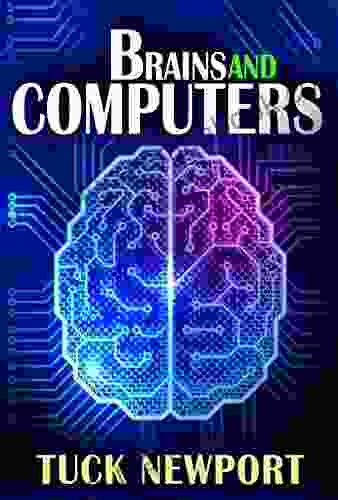Brains and Computers: Amino Acids Versus Transistors - Exploring the Similarities and Differences

The human brain and modern computers are both remarkable examples of complex information processing systems. Despite their vast differences in physical composition and operating principles, they share some striking similarities in their underlying mechanisms. One of the most fundamental parallels lies in the way they store and process information: using specialized units that interact through electrical signals. In the brain, these units are neurons that communicate via neurotransmitters, while in computers, they are transistors that transmit electrical pulses. In this article, we will delve into the fascinating world of brains and computers, exploring the similarities and differences between amino acids and transistors, the building blocks of these remarkable information processing systems.
The Neuron: The Basic Unit of the Brain
The brain is the control center of the nervous system, responsible for a vast array of functions, including thought, emotion, movement, and memory. It is composed of billions of interconnected neurons, specialized cells that transmit electrical signals to communicate with each other. Each neuron consists of a cell body, dendrites, and an axon. Dendrites are short, branched extensions that receive signals from other neurons, while the axon is a long, thin fiber that transmits signals to other neurons.
4 out of 5
| Language | : | English |
| File size | : | 162 KB |
| Text-to-Speech | : | Enabled |
| Enhanced typesetting | : | Enabled |
| Print length | : | 16 pages |
| Screen Reader | : | Supported |
At the heart of neuronal communication lies a complex chemical process involving neurotransmitters. Neurotransmitters are chemical messengers that are released by the axon terminal of one neuron and bind to receptors on the dendrites of adjacent neurons. This binding triggers a change in the electrical potential of the receiving neuron, either exciting it (making it more likely to fire) or inhibiting it (making it less likely to fire). The strength and duration of the signal are determined by the type of neurotransmitter, the number of receptors bound, and the duration of binding.
Amino Acids: The Building Blocks of Neurotransmitters
Neurotransmitters are synthesized from amino acids, the building blocks of proteins. There are 20 common amino acids that occur naturally in proteins, each with its own unique chemical structure and properties. Different neurotransmitters are synthesized from different combinations of amino acids. For example, the neurotransmitter glutamate, which is involved in excitatory signaling, is synthesized from the amino acid glutamic acid.
Amino acids are essential for the proper functioning of the brain. They provide the raw materials for the synthesis of neurotransmitters, which are critical for neuronal communication. Deficiencies in certain amino acids can lead to neurological disorders such as Parkinson's disease and Alzheimer's disease.
The Transistor: The Basic Unit of the Computer
A computer is an electronic device that can be programmed to carry out a sequence of instructions. It is composed of billions of transistors, tiny electronic switches that control the flow of electricity. Transistors are made of semiconductor materials, such as silicon, which have the ability to conduct electricity under certain conditions.
Transistors have three terminals: a source, a drain, and a gate. When a voltage is applied to the gate, it controls the flow of electricity between the source and the drain. By combining transistors in different ways, it is possible to create logic gates, which are the basic building blocks of digital circuits. Logic gates can be used to perform simple operations, such as AND, OR, and NOT. By combining logic gates, it is possible to create more complex circuits that can perform a wide range of tasks, such as processing data, storing information, and controlling devices.
Similarities Between Amino Acids and Transistors
Despite their vast differences in physical composition and operating principles, amino acids and transistors share some striking similarities:
- Both are essential building blocks of complex information processing systems. In the brain, amino acids are the building blocks of neurotransmitters, which are essential for neuronal communication. In computers, transistors are the building blocks of logic gates, which are the basic units of digital circuits.
- Both can be combined to create more complex structures. In the brain, neurons can be combined to form neural networks, which are capable of performing complex tasks such as learning and memory. In computers, logic gates can be combined to create more complex circuits, such as microprocessors, which are capable of performing a wide range of tasks.
- Both are subject to errors. Amino acids can be misfolded or damaged, leading to neurotransmitter imbalances and neurological disorders. Transistors can also malfunction, leading to errors in computation. However, both brains and computers have mechanisms in place to detect and correct errors.
Differences Between Amino Acids and Transistors
Despite their similarities, amino acids and transistors also have some important differences:
- Chemical versus electronic basis. Amino acids are biochemical molecules, while transistors are electronic devices. This difference in composition leads to different operating principles. Neurons communicate via chemical signals (neurotransmitters),while transistors communicate via electrical signals (electrical pulses).
- Speed of operation. Neurons communicate relatively slowly, with signals traveling at speeds of a few meters per second. Transistors, on the other hand, communicate much faster, with signals traveling at speeds close to the speed of light. This difference in speed is due to the different mechanisms of signal transmission: chemical versus electrical.
- Energy efficiency. Neurons are relatively energy-efficient, consuming only a small amount of energy to transmit signals. Transistors, on the other hand, are less energy-efficient, consuming more energy to transmit signals. This difference in energy efficiency is due to the different mechanisms of signal transmission: chemical versus electrical.
Brains and computers are both remarkable examples of complex information processing systems. Despite their vast differences in physical composition and operating principles, they share some striking similarities in their underlying mechanisms. Both systems use specialized units (neurons and transistors) to store and process information, and both systems are subject to errors. However, they also have some important differences, including their chemical versus electronic basis, speed of operation, and energy efficiency.
4 out of 5
| Language | : | English |
| File size | : | 162 KB |
| Text-to-Speech | : | Enabled |
| Enhanced typesetting | : | Enabled |
| Print length | : | 16 pages |
| Screen Reader | : | Supported |
Do you want to contribute by writing guest posts on this blog?
Please contact us and send us a resume of previous articles that you have written.
 Top Book
Top Book Novel
Novel Fiction
Fiction Nonfiction
Nonfiction Literature
Literature Paperback
Paperback Hardcover
Hardcover E-book
E-book Audiobook
Audiobook Bestseller
Bestseller Classic
Classic Mystery
Mystery Thriller
Thriller Romance
Romance Fantasy
Fantasy Science Fiction
Science Fiction Biography
Biography Memoir
Memoir Autobiography
Autobiography Poetry
Poetry Drama
Drama Historical Fiction
Historical Fiction Self-help
Self-help Young Adult
Young Adult Childrens Books
Childrens Books Graphic Novel
Graphic Novel Anthology
Anthology Series
Series Encyclopedia
Encyclopedia Reference
Reference Guidebook
Guidebook Textbook
Textbook Workbook
Workbook Journal
Journal Diary
Diary Manuscript
Manuscript Folio
Folio Pulp Fiction
Pulp Fiction Short Stories
Short Stories Fairy Tales
Fairy Tales Fables
Fables Mythology
Mythology Philosophy
Philosophy Religion
Religion Spirituality
Spirituality Essays
Essays Critique
Critique Commentary
Commentary Glossary
Glossary Bibliography
Bibliography Index
Index Table of Contents
Table of Contents Preface
Preface Introduction
Introduction Foreword
Foreword Afterword
Afterword Appendices
Appendices Annotations
Annotations Footnotes
Footnotes Epilogue
Epilogue Prologue
Prologue Jason Mclean
Jason Mclean Chris Brady
Chris Brady Tasha Chen
Tasha Chen Dena Przybyla
Dena Przybyla Isaac M Hamm Iii
Isaac M Hamm Iii Jeanne St James
Jeanne St James Sylvie Richard
Sylvie Richard Michael Winicott
Michael Winicott Tejas Mane
Tejas Mane Abigail Houston
Abigail Houston Tarek Riman
Tarek Riman Cathy Maxwell
Cathy Maxwell Diann Mills
Diann Mills Robert Henri
Robert Henri Therese Quinn
Therese Quinn Laurel Veil
Laurel Veil Katherine Mansfield
Katherine Mansfield David St John
David St John Dion E Betts
Dion E Betts Karel Capek
Karel Capek
Light bulbAdvertise smarter! Our strategic ad space ensures maximum exposure. Reserve your spot today!

 Mark TwainYou Still Have Time: A Comprehensive Guide to Overcoming Procrastination and...
Mark TwainYou Still Have Time: A Comprehensive Guide to Overcoming Procrastination and...
 Kenzaburō ŌeThe Sayyid of Bagdad: A Haunting Tale of Love and Loss by Elizabeth Barrett...
Kenzaburō ŌeThe Sayyid of Bagdad: A Haunting Tale of Love and Loss by Elizabeth Barrett...
 Percy Bysshe ShelleyDiscover the Enchanting Crochet Country Garden Collection: A Tapestry of...
Percy Bysshe ShelleyDiscover the Enchanting Crochet Country Garden Collection: A Tapestry of... Richard SimmonsFollow ·8.6k
Richard SimmonsFollow ·8.6k Jared PowellFollow ·13k
Jared PowellFollow ·13k Arthur Conan DoyleFollow ·3.2k
Arthur Conan DoyleFollow ·3.2k Jace MitchellFollow ·17.4k
Jace MitchellFollow ·17.4k Terry PratchettFollow ·2.8k
Terry PratchettFollow ·2.8k Herman MitchellFollow ·8.6k
Herman MitchellFollow ·8.6k Ralph TurnerFollow ·18.8k
Ralph TurnerFollow ·18.8k Denzel HayesFollow ·4.4k
Denzel HayesFollow ·4.4k

 Cody Blair
Cody BlairWill You Ever Pee Alone Again? The Future of Bathroom...
The bathroom has long been a place of...

 Al Foster
Al FosterNine Years Among the Indians 1870-1879: Witnessing Their...
In the annals of American...

 Pete Blair
Pete BlairYekl and the Imported Bridegroom: A Window into the New...
Abraham Cahan's Yekl and the...

 Pablo Neruda
Pablo NerudaSearch Engine Optimization Guide: A Non-Technical...
In today's digital landscape, having a...

 Nikolai Gogol
Nikolai GogolOne Piece Vol 77: Smile - The Saga Continues with...
The Enthralling World...

 Dan Henderson
Dan HendersonThree Farmers On Their Way To Dance
In a quaint countryside...
4 out of 5
| Language | : | English |
| File size | : | 162 KB |
| Text-to-Speech | : | Enabled |
| Enhanced typesetting | : | Enabled |
| Print length | : | 16 pages |
| Screen Reader | : | Supported |






